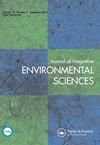Methane emissions from fossil fuels: exploring recent changes in greenhouse-gas reporting requirements for the State of New York
IF 3.5
4区 环境科学与生态学
Q3 ENVIRONMENTAL SCIENCES
Journal of Integrative Environmental Sciences
Pub Date : 2020-08-25
DOI:10.1080/1943815X.2020.1789666
引用次数: 13
Abstract
ABSTRACT In 2019, New York State passed aggressive new climate legislation to reduce greenhouse gas (GHG) emissions and laid out major changes for how emissions are reported. One change is the inclusion of emissions from outside of the boundaries of the State if they are associated with energy use within NY; the traditional inventory considered emissions only within the State. The new legislation also mandated that methane emissions be compared with carbon dioxide over a 20-year time frame rather than the 100-year time frame previously used by NY and still used by virtually all other governments globally. This reflected the desire of NY's policymakers for a tool that evaluates emissions from the standpoint of energy consumption and that more heavily weighs the role of methane as an agent of warming over the next few decades. This paper compares emissions based on the new approach for GHG reporting with the traditional inventory. The traditional inventory is driven almost entirely by carbon dioxide emissions. As of 2015, these carbon dioxide emissions had declined by 15% since 1990 due to an 88% decrease in coal consumption and a 27% decrease in consumption of petroleum products, although consumption of natural gas had increased by 57%. Methane emissions increased by almost 30% between 1990 and 2015, largely due to the increased consumption of natural gas. According to the new GHG reporting rules, methane contributed 28% of all fossil-fuel emissions in 1990 and 37% in 2015. Total GHG emissions remained virtually unchanged from 1990 to 2015.化石燃料产生的甲烷排放:探索纽约州温室气体报告要求的最新变化
2019年,纽约州通过了积极的新气候立法,以减少温室气体(GHG)排放,并对排放报告方式进行了重大改革。一项变化是,如果与纽约州境内的能源使用有关,则将州外的排放纳入其中;传统的清单只考虑国家内部的排放。新的立法还要求将甲烷排放量与二氧化碳排放量进行20年时间框架的比较,而不是纽约州之前使用的100年时间框架,目前全球几乎所有其他政府都在使用这一框架。这反映了纽约州政策制定者希望有一种工具能够从能源消耗的角度来评估排放,并更重地衡量甲烷在未来几十年作为变暖因素的作用。本文将基于新方法的温室气体报告与传统清单的排放量进行了比较。传统的库存几乎完全由二氧化碳排放驱动。截至2015年,尽管天然气消费量增长了57%,但由于煤炭消费量下降了88%,石油产品消费量下降了27%,二氧化碳排放量自1990年以来下降了15%。1990年至2015年间,甲烷排放量增加了近30%,这主要是由于天然气消费量的增加。根据新的温室气体报告规则,1990年甲烷占所有化石燃料排放的28%,2015年为37%。从1990年到2015年,温室气体排放总量几乎没有变化。
本文章由计算机程序翻译,如有差异,请以英文原文为准。
求助全文
约1分钟内获得全文
求助全文
来源期刊

Journal of Integrative Environmental Sciences
ENVIRONMENTAL SCIENCES-
CiteScore
3.90
自引率
0.00%
发文量
13
审稿时长
>12 weeks
期刊介绍:
Journal of Integrative Environmental Sciences (JIES) provides a stimulating, informative and critical forum for intellectual debate on significant environmental issues. It brings together perspectives from a wide range of disciplines and methodologies in both the social and natural sciences in an effort to develop integrative knowledge about the processes responsible for environmental change. The Journal is especially concerned with the relationships between science, society and policy and one of its key aims is to advance understanding of the theory and practice of sustainable development.
 求助内容:
求助内容: 应助结果提醒方式:
应助结果提醒方式:


